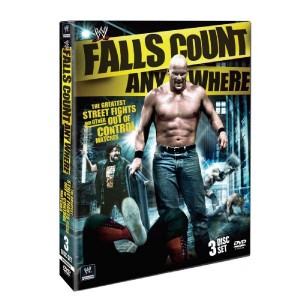Only a few weeks after the ECW Unreleased Volume 1 DVD set crashed onto store shelves, WWE releases another DVD set dedicated to some of wrestling’s most violent matches with Falls Count Anywhere: The Greatest Street Fights and Other Out of Control Matches. Spanning more than 30 years of chaos, Falls Count Anywhere includes more than two dozen matches from the National Wrestling Alliance, World Championship Wrestling, the World Wrestling Federation, Extreme Championship Wrestling and recent WWE history. But as you might imagine, it’s the older footage that offers a more genuine atmosphere of disorder and mayhem.
 Beginning with a bloody WWF alley fight between Pat Patterson and Sgt. Slaughter at Madison Square Garden in 1981, the first disc is dominated by old NWA and WCW footage featuring the likes of the Four Horsemen, the Road Warriors, Doom and Sting. And if you’re looking for a single match that epitomizes the zany spirit of a street fight, you need look no further than the tag team match between Jimmy Valiant and Ms. Atlanta Lively taking on the Midnight Express at the Omni. This match features a cross-dressing competitor, powder being thrown into the eyes of adversaries, foreign objects and the involvement of Midnight Express manager Jim Cornette (and his signature tennis racket). Taking place at a time when fans truly didn’t know what might happen during a match like this, you can just feel the tumultuous energy as it unfolds in these matches form the ’80s and early ’90s.
Beginning with a bloody WWF alley fight between Pat Patterson and Sgt. Slaughter at Madison Square Garden in 1981, the first disc is dominated by old NWA and WCW footage featuring the likes of the Four Horsemen, the Road Warriors, Doom and Sting. And if you’re looking for a single match that epitomizes the zany spirit of a street fight, you need look no further than the tag team match between Jimmy Valiant and Ms. Atlanta Lively taking on the Midnight Express at the Omni. This match features a cross-dressing competitor, powder being thrown into the eyes of adversaries, foreign objects and the involvement of Midnight Express manager Jim Cornette (and his signature tennis racket). Taking place at a time when fans truly didn’t know what might happen during a match like this, you can just feel the tumultuous energy as it unfolds in these matches form the ’80s and early ’90s.
Known for his numerous fights of this nature in WCW, ECW and WWE, “The Hardcore Legend” himself Mick Foley is an obvious choice to host this collection. But what’s somewhat surprising is the fact that he (as Cactus Jack) is only featured in two of Falls Count Anywhere‘s matches (one of my personal favorites from his feud with Sting in 1992, and against Triple H in 1997). What’s equally surprising is that “Stone Cold” Steve Austin, who is featured prominently on the DVD cover, is only featured in one match here. But it’s a brutal bout that culminates his feud with Bret Hart (and sees Stone Cold attack Hart in an ambulance after the conclusion of the match). And it’s an apt way to conclude the first disc since it signifies a time when street fights and the like were the breaking point of most rivalries, with both competitors pulling out all the stops to come out victorious.
With the influence of ECW’s more hardcore style, the ’90s saw an influx of street fights, strap matches and the emergence of the Hardcore Championship, which could be defended under pretty much any circumstances. That being said, the only ECW match included here features two of the hardest of the hardcore; Tazz and Bam Bam Bigelow. Hardore matches took on a very different tone and served a somewhat different purpose during the Attitude Era, and the matches on the second disc are indicative of this evolution. From Al Snow and Hardcore Holly battling into the Mississippi River for the Hardcore Championship to Mr. McMahon taking on his son Shane McMahon (and Ric Flair just a few months later), a majority of the matches on the second disc take place in 1999, which is proof of just how commonplace the idea had become by this time.
The third disc shows these types of no-holds-barred matches being reserved for dramatic conclusions or momentous turning points once again. From Shawn Michaels‘ heartfelt return after four years against his best friend Triple H in an unsanctioned street fight at 2002’s SummerSlam to a brutal street fight between Rey Mysterio and one-time friend Batista on SmackDown in 2009, the more recent matches feature more of the unpredictability of the stuff from the ’80s (and require a bit more emotional investment than the matches from the ’90s and early 2000s). We also see younger and less established talents such as Umaga, Cody Rhodes and Ted DiBiase rising to the chaotic occasion and using street fights (and fresher concepts such as a submissions count anywhere match between D-Generation X and Legacy at 2009’s Breaking Point) to elevate themselves closer to main event status. And the inclusion of a WWE Women’s Championship match between Melina and Mickie James from 2007 shows that falls count anywhere matches are not strictly for men.
Though it could be argued that Falls Count Anywhere suffers from the omission of certain matches (such as the last man standing match between John Cena and Batista at 2010’s Extreme Rules or anything from Memphis’ Continental Wrestling Association, arguably the birthplace of this style of match), it’s still another enjoyable collection of matches form WWE’s extensive vault of footage. And considering the extent of footage in WWE’s possession, it wouldn’t surprise me if we saw separate last man standing and Memphis collections in the near future anyway.
For more information, go to www.wweshop.com.
